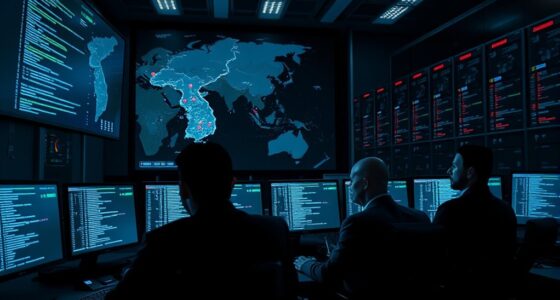APT41, known as “Double Dragon,” is a highly capable Chinese hacking group that combines cyber espionage with financial cybercrime. They target government, tech, healthcare, and gaming sectors worldwide to steal sensitive data and intellectual property. Using advanced tactics like spear-phishing, zero-day exploits, and stealthy malware, they stay undetected for long periods. Understanding their methods reveals how China’s hybrid approach blends espionage and crime, and if you keep exploring, you’ll uncover even more about their evolving tactics and global impact.
Key Takeaways
- APT41, also known as “Double Dragon,” is a Chinese state-sponsored group combining cyber espionage and financially motivated cybercrime.
- They utilize advanced techniques like spear-phishing, zero-day exploits, and fileless malware to infiltrate various targets worldwide.
- Their operations target government, tech, healthcare, and gaming sectors to steal intellectual property and sensitive data.
- APT41 operates with significant resources, acting under Chinese intelligence, blending espionage tactics with cybercriminal activities.
- Their persistent, stealthy campaigns aim to gather strategic intelligence and economic advantages over extended periods.

While many nations engage in cyber operations, China’s APT41, also known as “Double Dragon,” stands out for its sophisticated blend of hacking and espionage. This group exemplifies how state-sponsored hacking can be used as a tool for cyber espionage, targeting a wide range of industries and governments worldwide. You might notice that APT41’s operations go beyond simple cybercrime; they’re deeply embedded in strategic intelligence gathering, often aligning with China’s national interests. Their cyber espionage campaigns are designed to infiltrate networks, extract sensitive data, and maintain long-term access without detection. This dual approach of combining cyber espionage with financially motivated hacking makes APT41 particularly versatile and dangerous. Their techniques include high-level cyber espionage tactics such as spear-phishing, malware deployment, and exploiting zero-day vulnerabilities, which require advanced skills and resources.
You should understand that APT41’s activities are a clear example of how state-sponsored hacking isn’t just about disrupting systems but also about harvesting intelligence. Their techniques include spear-phishing, malware deployment, and exploiting zero-day vulnerabilities. These methods allow them to target government agencies, technology firms, healthcare organizations, and even gaming companies. The intent is to steal intellectual property, gain insights into foreign policies, or gather competitive advantages. Their operations often blur the lines between cyber espionage and cybercrime, making it challenging for defenders to respond effectively. Recognizing the cyber threat landscape is crucial to developing effective security strategies. Additionally, their campaigns frequently adapt to emerging security measures, demonstrating a high level of technological sophistication. This ongoing evolution highlights the importance of continuous monitoring and the development of robust safety measures to counteract such threats.
In your efforts to defend against such threats, it’s essential to recognize that APT41 operates with significant resources and expertise, often working under the direction of Chinese intelligence agencies. They’re not just hackers; they’re strategic actors using cyber tools as part of a broader geopolitical game. Their campaigns often involve persistent, low-profile intrusions designed to stay hidden for months or even years. They use stealthy techniques like fileless malware and encrypted communication channels, making detection difficult. You need to think of them as a hybrid threat—part espionage agent, part criminal—whose goal is to gather as much intelligence as possible while avoiding attribution.
Understanding APT41’s blend of cyber espionage and state-sponsored hacking helps you appreciate the threat landscape better. These operations are not isolated incidents but part of a well-funded, highly coordinated effort to advance China’s strategic interests globally. Recognizing their tactics, techniques, and procedures is indispensable for building stronger defenses. The key takeaway is that APT41’s activities reflect a calculated approach to cyber operations—focused on intelligence gathering, economic advantage, and geopolitical influence—making them one of the most formidable cyber adversaries you face today.
Frequently Asked Questions
How Does APT41 Select Its Target Organizations?
You might wonder how APT41 chooses its targets. They assess organizations based on geopolitical motives and strategic intelligence, focusing on entities that can provide valuable information or influence. They often target industries aligned with China’s national interests, such as technology, healthcare, and government sectors. By analyzing vulnerabilities and geopolitical significance, they select targets that help advance their country’s strategic goals, maximizing impact through well-planned cyber operations.
What Tools Does APT41 Typically Use in Their Attacks?
Oh, you thought hackers only used basic tools? Think again. APT41 employs sophisticated cyber espionage techniques, deploying custom malware and exploiting zero-day vulnerabilities. They favor tools like Cobalt Strike, PlugX, and malware-laden phishing kits, blending malware deployment with stealth. Their arsenal allows them to infiltrate networks, siphon data, and stay hidden — proving that in hacking, as in life, it’s all about the right tools at the right time.
How Does China Justify or Explain Apt41’s Activities?
You might wonder how China justifies APT41’s activities. They often frame these operations through state-sponsored narratives, claiming they serve national security interests. China argues that these cyber activities are essential for protecting its sovereignty, economic growth, and technological advancement. They tend to see APT41’s actions as legitimate, emphasizing their role in safeguarding national security rather than malicious hacking, even though international observers view them differently.
What Are the Potential Economic Impacts of Apt41’S Operations?
You might not realize it, but cyber-espionage causes billions in losses annually. APT41’s operations threaten your economy by increasing market vulnerabilities and causing economic disruption. When hackers target sensitive data, they undermine trust, inflate costs, and slow innovation. This risks destabilizing industries and national growth. The potential economic impact is significant, as these breaches can lead to long-term damage that affects both your business environment and overall economic stability.
How Can Organizations Detect Apt41’S Presence Early?
To detect APT41 early, you should focus on behavioral indicators like unusual login patterns and data access anomalies. Conduct proactive threat hunting to identify hidden signs of compromise, such as suspicious file modifications or command executions. Regularly monitor network traffic and system logs, and train your team to recognize subtle signs of malicious activity. Early detection hinges on vigilant monitoring, quick response, and understanding the tactics attackers often use.
Conclusion
As you watch APT41’s relentless operations unfold, you realize their true power lies in blending hacking with espionage, blurring the lines between cybercrime and state-sponsored spying. What’s next for this double-edged dragon? Will their next move expose even deeper secrets or spark a new wave of global cyber conflicts? Stay alert—what they’re capable of remains just beyond your reach, waiting in the shadows for the perfect moment to strike again.








